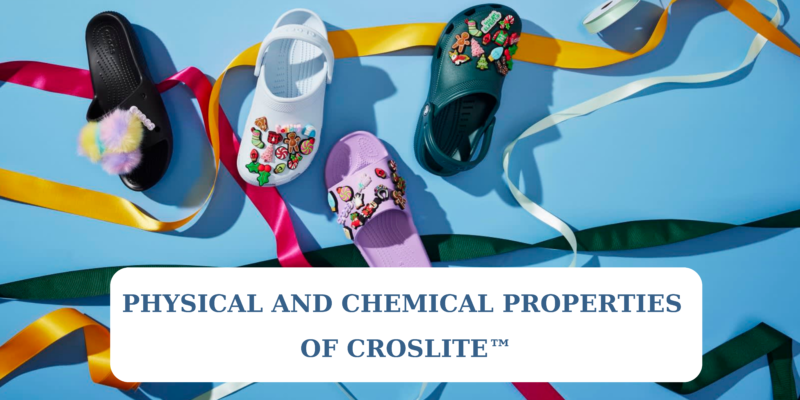Clogs Tips & News - Trendycroc's Blog
Physical And Chemical Properties Of Croslite™
When it comes to Croslite, we immediately think of the heart of Crocs. Croslite is a revolutionary material in the footwear industry. Composed of a proprietary closed-cell resin, Croslite has redefined comfort and practicality. It’s more than just foam, it’s a substance that blends softness and durability with a lightweight nature. Unlike traditional EVA foam, Croslite offers advantages making it perfect for all-day wear. In everyday use, Croslite footwear provides a perfect blend of comfort, support, and durability that few materials can match. So, what are the physical and chemical properties of Croslite? Let’s check it out with us.

Understanding the Physical and Chemical Properties of Croslite

Croslite is a unique closed-cell resin material, that has revolutionized the footwear industry with its distinct physical and chemical properties. Let’s delve into what makes Croslite so special.
Physical Properties

Lightweight Nature
Croslite is incredibly lightweight, therefore it is ideally used for footwear that requires ease of movement. This property is a key reason why shoes made from Croslite are comfortable for extended wear.
Shock Absorption
One of the standout physical characteristics of Croslite is its exceptional shock absorption. The material cushions each step, reducing the impact on joints and feet, which contributes to a more comfortable walking experience.
Water Resistance
This can be seen as the most outstanding feature of Croslite. Thanks to its closed-cell structure, it is highly water-resistant. This means that this material doesn’t absorb water, making it perfect for footwear intended for wet environments or activities.
Elasticity and Compressibility
Croslite is both elastic and compressible, allowing it to adapt to the foot’s shape. This flexibility not only enhances comfort but also helps in maintaining the material’s structural integrity over time.
Durability
Despite its lightweight and soft nature, Croslite is incredibly durable. It resists wear and tear effectively, ensuring that footwear made from it lasts longer than those made from many other materials.
Chemical Properties

Non-Toxic Composition
Croslite is non-toxic, making it safe for prolonged skin contact. This property is essential for footwear, as it ensures that the material won’t cause irritation or harm to the skin.
Heat Molding Capability
Croslite can be heat-molded, allowing footwear customization to fit specific foot shapes. This property is particularly beneficial in creating ergonomic and custom-fit shoes.
Stability and Resistance
Chemically, Croslite is stable and resistant to various environmental factors such as UV light and exposure to certain chemicals. This stability helps in maintaining the material’s integrity and appearance over time.
Anti-Microbial Properties
Croslite’s composition includes anti-microbial properties, which help in preventing the growth of bacteria and fungi. This feature is crucial in maintaining foot hygiene and preventing odors.
Low Thermal Conductivity
Croslite has low thermal conductivity, meaning it doesn’t easily transfer heat. This property ensures that footwear made from Croslite remains comfortable across different temperatures, neither becoming too hot in warm conditions nor too cold in cooler environments.
Croslite vs. Other Materials: What Makes it Stand Out?

Croslite stands out from other materials due to its unique properties. Its thermal stability ensures that it performs well in various temperatures, while its water resistance makes it suitable for wet environments. Having many different features with many other materials, Croslite is non-toxic and has anti-microbial properties, thus, it is safe and hygienic for prolonged use. Moreover, its slip resistance is a significant safety feature, especially in environments where traction is critical.
Environmental Impact of Croslite: Is it Sustainable?

In terms of sustainability, Croslite presents some interesting points. Its manufacturing process, which involves injection molding, is designed for efficiency and minimal waste. Moreover, the longevity of Croslite footwear means that it doesn’t need to be replaced as often as products made from less durable materials, contributing to its environmental appeal. While Croslite isn’t biodegradable, its reusability and long lifespan make it a relatively sustainable option when compared to materials like EVA foam.
Conclusion
To sum up, Croslite represents a unique combination of physical and chemical properties making it an exceptional material for footwear, especially Crocs. Crocs is the most successful application of Croslite in footwear production. Croslite’s lightweight, durable, and comfortable nature, coupled with its resistance to water, heat, and microbes, ensures that shoes made from Croslite stand out in both performance and longevity. If you’re navigating through wet conditions or seeking all-day comfort, Croslite’s advanced properties have got you covered.
Now, you’re at the right place, we have what you need, let’s explore our best-trending collection of Crocs, from Anime Crocs, Cartoon Crocs, Movie Crocs, and so on. We have a vast collection that will not disappoint you at all.

Chloe Carney is a dedicated content specialist at Trendy Croc, where she combines her passion for fashion and footwear with her expertise in digital content creation. With a well-educated background and wealthy working experience, she crafts engaging and informative content that resonates with lots of Crocs enthusiasts.
1. Education
2.Working Experience
3.Contact